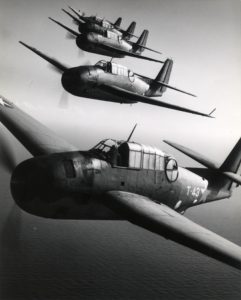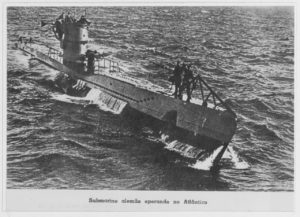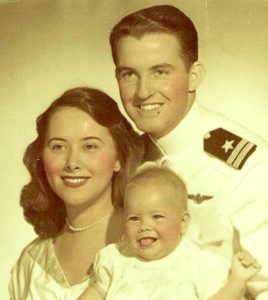[This is the second in a series of four articles honoring the 75th anniversary of the Battle of Point Judith. This article is based on part of a chapter written by the author in the recently-published book Untold Stories of World War II Rhode Island (History Press, 2019).]
In 2010, John G. Bradley, Jr., a former pilot raised in Hartford, Connecticut, told a remarkable story about U-853, the German U-boat that sank the coal collier Black Point on May 5, 1945, south of Point Judith, and hours later was itself attacked and went down within sight of Point Judith. The following is based on the 2010 interview of Bradley by Scott R. Stets (available on YouTube) and my own 2018 interview with Bradley at the Wickford Yacht Club, where at age 94, he still moored his sail boat.
Early in the morning of May 5, 1945, with Germany’s surrender just two days away, Ensign John Bradley and his temporary radioman, Clifford I. Brinson, took off from Naval Air Station Quonset Point and flew their TBM Avenger to a designated point in Long Island Sound, south of New London, Connecticut. Bradley’s orders were to help train the crew of a submarine operating out of Groton to spot approaching enemy aircraft. Submarines in World War II operated by battery power underwater and diesel power on the surface. Submarines regularly had to surface to recharge their batteries, making them vulnerable to enemy aircraft. Bradley was directed to fly out to the horizon and then fly back to the submarine from random directions, so that lookouts on the submarine’s conning tower could try to spot his approaching plane. With fog setting in, the training exercise ended at 10:15 a.m.

Ensign John Bradley flew out Quonset Point Naval Air Station on May 5, 1945, on a TBF Avenger. It was one of the most common planes flown from Quonset Point and was used on aircraft carriers in the Pacific for bombing and air-to-air fighting (Naval History and Heritage Command)
Bradley then flew his Avenger ten miles south of Fisher’s Island and turned east toward Block Island, patrolling his assigned sector. Suddenly, Brinson turned to his pilot and said, “Mr. Bradley, I can’t believe my eyes. There is a German submarine just east of Montauk, Long Island.” Bradley looked over and saw it. They could tell it was a U-boat because of its distinctive “laundry-basket” conning tower and angular hull of a type IX-C U-boat. No doubt its commander was recharging the U-boat’s batteries.
Bradley lacked live weapons on board his aircraft to attack the submarine. He recalled that he was under orders not to use his VHF radio, as it could be easily picked up by the German submarine. He thought the best chance to sink the enemy submarine was to fly back to Quonset Point and report the sighting immediately, where hunter-killer aircraft could be sent out to locate and attack the submarine (or at least scare it away). Bradley peeled off and sped at wave-top height toward Quonset, hoping the German submariners had not spotted him.
Proceeding up the West Passage of Narragansett Bay in increasing fog, Bradley landed his plane on the northwest runway at Quonset Point, taxied over to seaplane hangar 3, and parked his aircraft. He then sprinted to the Administration Building to inform the commanding officer of NAS Quonset Point, Dixie Kiefer, of what he saw. Bradley met an aide outside of Kiefer’s office, who assigned a combat information officer (CIO) to meet with Bradley and Brinson (Bradley thinks his name was Monaghan).
The CIO debriefed Bradley and Brinson about the U-boat sighting. The CIO expressed skepticism, despite Bradley firmly stating, “We know what we saw, there was no question about it.” Bradley added information about the U-boat’s speed and direction, which would allow its eastward course to be plotted. The debriefing started at 1 p.m. and ended three hours later. The CIO officer occasionally left the room and returned. He must have been consulting with a superior officer (could it have been the station’s highly-decorated officer, Dixie Kiefer?).

Ensign John Bradley and Clifford Brinson saw from the sky an aerial view similar to this one, of a German U-boat steaming on the Atlantic Ocean’s surface (Naval History and Heritage Command)
Once, after returning from another such visit, the CIO said he knew that Bradley and Brinson had been out at a Providence bar until 3 a.m. that morning. Bradley conceded the point but said that he and Brinson did not drink.
It did not help that Bradley and Brinson were recent arrivals at Quonset Point. Bradley and his squadron had flown up from Norfolk, Virginia, about a week prior to May 5.
On his way out, the CIO told Bradley and Brinson he would report the sighting to the headquarters of the cruiser-destroyer fleet at Newport. When Bradley went outside after the debriefing, he recalled that heavy fog had rolled in.
That evening, at about 5:40 p.m., the commander of the German submarine U-853 spotted the merchant vessel Black Point less than three miles southeast of Point Judith and fired a single torpedo at it. The torpedo smashed into the vessel’s stern—the ensuing explosion and vessel’s sinking killed eleven crew members and one armed guard. Thirty-four survivors were rescued by small craft operating out of the Coast Guard Station at Point Judith and from Quonset Point. The next morning, still within sight of Point Judith, the German submarine was sunk by hedgehogs and depth charges deployed by the Coast Guard frigate Moberly and Navy destroyer escort Atherton. All fifty-five of the U-boat’s crew perished.
No evidence has appeared of Bradley’s report or that it was conveyed to Newport or acted upon. Bradley still agonizes to this day whether his information if acted upon could have saved lives. Based on the projected course and speed of the U-boat he sighted, Bradley calculated it would have arrived off Point Judith at about the time Black Point was sunk. Thus, he is confident he and Brinson had spotted U-853.
Bradley believes that even if the information had been conveyed to Newport headquarters and acted upon quickly, there was not sufficient time to send out antisubmarine warships after 4 p.m. on May 5 and to sink the enemy submarine before it attacked Black Point at 5:40 p.m. His assessment is correct. It appears that all of the Newport-based destroyers were on patrol at the time and not near Point Judith. It typically took hours to gather a crew and start up the engines of a heavy cruiser. In the foggy conditions, it would have been dangerous to send out hunter-killer antisubmarine aircraft from Quonset Point or Charlestown.
On the other hand, the information that an enemy submarine could be lurking in Rhode Island Sound could have been immediately radioed to commercial ships operating in Rhode Island Sound and Block Island Sound. The unsuspecting captain of Black Point, oblivious to the risk of a U-boat attack, did not even post lookouts or adopt the tactic of zig-zagging to avoid enemy torpedoes.
A naval historian who reviewed the above story wrote to me: “The story sounds quite credible that Bradley’s aircraft sighted U-853, but it is also quite credible that the crew were not believed and no action was taken. One of the most difficult things in war is to know what intelligence is correct and which of the bits of information needs to be acted upon immediately.”
I found contemporary records confirming Bradley service as a pilot trainee from Connecticut, Brinson’s service in southern New England with an aircraft squadron, and some other details consistent with Bradley’s story. I could not locate anyone from Brinson’s family.
[Banner image: When he saw U-853 on May 5, 1945, Ensign John Bradley was flying a TBF Avenger out of Quonset Point Naval Air Station (Naval History and Heritage Command)]
Bibliography
Original Sources
“Angus and [John G.] Bradley Awarded Commissions.” Hartford Courant, Nov. 9, 1944.
Bradley, John G. Interview by Christian McBurney, July 2, 2018.
Bradley, John G. Interview by Scott R. Stets of Phoenix Rising Films, 2010. On YouTube at https://www.youtube.com/watch?v=QoY79zv20s4 (accessed June 27, 2018).
War Diary of Torpedo Squadron 44, from April 5 ,1945 to June 30, 1945, at www.fold3.com (click on World War II records and search for “Clifford I. Brinson”).


























